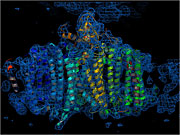Home > Press > An X-ray laser captures the structures of life
 |
| An X-ray laser captures the structures of life |
Abstract:
Two studies published recently in Nature demonstrate how the unique capabilities of the world's first hard X-ray free-electron laser—the Linac Coherent Light Source, located at DOE's SLAC National Accelerator Laboratory—could revolutionize the study of life.
An X-ray laser captures the structures of life
Menlo Park, CA | Posted on March 21st, 2011In one study, an international research team used the LCLS to demonstrate a shortcut for determining the 3-D structures of proteins.
The laser's brilliant pulses of X-ray light pulled structural data from tiny
protein nanocrystals, avoiding the need to use large protein crystals
that can be difficult or impossible to prepare. This process could lop
years off the structural analysis of some proteins and allow scientists
to decipher tens of thousands of others that are out of reach
today, including many involved in infectious disease.
In a separate paper, the same team reported making the first single-shot images of intact viruses, paving the way for snapshots and movies of molecules, viruses and live microbes in action.
Since the publication of these papers, members of the research team have returned to SLAC to continue their studies of proteins involved in photosynthesis, parasitic disease and other important life processes. Using the Coherent X-ray Imaging instrument (CXI)—the fourth instrument to become operational since the LCLS opened for research in 2009—the researchers shined highly energetic "hard" X-rays at the photosynthetic protein complex Photosystem I and an enzyme that breaks down proteins, extracted from the parasite that causes African sleeping sickness.
Though the results of these more recent studies won't be known until extensive analysis of the data has been completed, the researchers were extremely excited to see fine, crisply detailed protein structures at near atomic-scale resolution.
"It's going very well," said SLAC researcher Marvin Seibert, grinning. "The fireworks are back. It's always fun."
####
For more information, please click here
Copyright © DOE
If you have a comment, please Contact us.Issuers of news releases, not 7th Wave, Inc. or Nanotechnology Now, are solely responsible for the accuracy of the content.
| Related News Press |
News and information
![]() Researchers develop molecular qubits that communicate at telecom frequencies October 3rd, 2025
Researchers develop molecular qubits that communicate at telecom frequencies October 3rd, 2025
![]() Next-generation quantum communication October 3rd, 2025
Next-generation quantum communication October 3rd, 2025
![]() "Nanoreactor" cage uses visible light for catalytic and ultra-selective cross-cycloadditions October 3rd, 2025
"Nanoreactor" cage uses visible light for catalytic and ultra-selective cross-cycloadditions October 3rd, 2025
![]() Researchers tackle the memory bottleneck stalling quantum computing October 3rd, 2025
Researchers tackle the memory bottleneck stalling quantum computing October 3rd, 2025
Laboratories
![]() Researchers develop molecular qubits that communicate at telecom frequencies October 3rd, 2025
Researchers develop molecular qubits that communicate at telecom frequencies October 3rd, 2025
Imaging
![]() ICFO researchers overcome long-standing bottleneck in single photon detection with twisted 2D materials August 8th, 2025
ICFO researchers overcome long-standing bottleneck in single photon detection with twisted 2D materials August 8th, 2025
![]() Simple algorithm paired with standard imaging tool could predict failure in lithium metal batteries August 8th, 2025
Simple algorithm paired with standard imaging tool could predict failure in lithium metal batteries August 8th, 2025
![]() First real-time observation of two-dimensional melting process: Researchers at Mainz University unveil new insights into magnetic vortex structures August 8th, 2025
First real-time observation of two-dimensional melting process: Researchers at Mainz University unveil new insights into magnetic vortex structures August 8th, 2025
![]() New imaging approach transforms study of bacterial biofilms August 8th, 2025
New imaging approach transforms study of bacterial biofilms August 8th, 2025
Govt.-Legislation/Regulation/Funding/Policy
![]() New imaging approach transforms study of bacterial biofilms August 8th, 2025
New imaging approach transforms study of bacterial biofilms August 8th, 2025
![]() Electrifying results shed light on graphene foam as a potential material for lab grown cartilage June 6th, 2025
Electrifying results shed light on graphene foam as a potential material for lab grown cartilage June 6th, 2025
![]() Institute for Nanoscience hosts annual proposal planning meeting May 16th, 2025
Institute for Nanoscience hosts annual proposal planning meeting May 16th, 2025
Announcements
![]() Rice membrane extracts lithium from brines with greater speed, less waste October 3rd, 2025
Rice membrane extracts lithium from brines with greater speed, less waste October 3rd, 2025
![]() Researchers develop molecular qubits that communicate at telecom frequencies October 3rd, 2025
Researchers develop molecular qubits that communicate at telecom frequencies October 3rd, 2025
![]() Next-generation quantum communication October 3rd, 2025
Next-generation quantum communication October 3rd, 2025
![]() "Nanoreactor" cage uses visible light for catalytic and ultra-selective cross-cycloadditions October 3rd, 2025
"Nanoreactor" cage uses visible light for catalytic and ultra-selective cross-cycloadditions October 3rd, 2025
Tools
![]() Japan launches fully domestically produced quantum computer: Expo visitors to experience quantum computing firsthand August 8th, 2025
Japan launches fully domestically produced quantum computer: Expo visitors to experience quantum computing firsthand August 8th, 2025
![]() Rice researchers harness gravity to create low-cost device for rapid cell analysis February 28th, 2025
Rice researchers harness gravity to create low-cost device for rapid cell analysis February 28th, 2025
|
|
||
|
|
||
| The latest news from around the world, FREE | ||
|
|
||
|
|
||
| Premium Products | ||
|
|
||
|
Only the news you want to read!
Learn More |
||
|
|
||
|
Full-service, expert consulting
Learn More |
||
|
|
||








